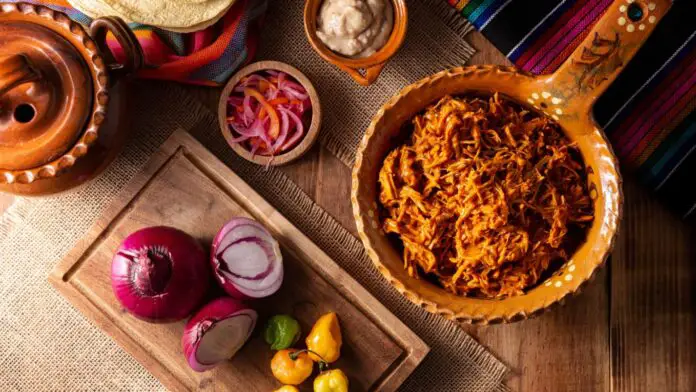Yucatan has been named the Ibero-American Capital of Gastronomy 2025 at FITUR, highlighting its rich culinary tradition and its impact on Mexican and global cuisine. Yucatecan gastronomy is a fusion of Mayan culture and European influences, resulting in dishes with native ingredients and unique techniques. From stews cooked in earthen ovens (pib) to colonial-inspired preparations, Yucatan cuisine reflects its history and biodiversity. Here are some of the most iconic and unique dishes of the region:
1. Cochinita Pibil: Delicacy of the Mayan Gods
Cochinita pibil is the flagship dish of Yucatecan cuisine. It is named after the cooking process in a pib, an earthen oven that gives the pork marinated with achiote and sour orange its tenderness and smoky flavor. In pre-Hispanic times, this delicacy was reserved for large celebrations and was made with deer or wild turkey. Authentic cochinita is wrapped in banana leaves before slow cooking, allowing the meat to retain its juice and aroma.
2. Relleno Negro: The Magic of Chilmole
Relleno negro is a stew known for its deep flavor, derived from chilmole, a mixture of chiles roasted until completely black, resulting in a thick, jet-black broth. It is served with shredded turkey and but negro, a meatball of meat and hard-boiled egg that absorbs the stew’s potency. Originally prepared for holidays, this dish is also considered an effective hangover remedy.
3. Queso Relleno: The Dutch Nod to Mayan Cuisine
Queso relleno tells the story of Yucatecan trade. In the 19th century, Dutch ships arrived with Edam cheese as ballast, and the Yucatecans turned it into a delicacy by stuffing it with minced pork, raisins, olives, and spices, then bathing it in a white sauce and a tomato sauce. The fusion of European and local ingredients makes it unique.
4. Papadzules: Pre-Hispanic Tacos
Papadzules are one of the oldest dishes in Yucatan, believed to have been consumed before the Spanish arrived. They are corn tortillas filled with boiled egg, bathed in pumpkin seed sauce, and decorated with a touch of tomato. The name comes from the Mayan “papak,” meaning “to soak,” and “dzul,” referring to nobles.
5. Venison Tzic: A Dish with History
Venison tzic is a stew of shredded meat marinated with sour orange, radishes, and red onion, showcasing how hunting has been integral to the Yucatecan diet. While it is now usually made with beef, the Mayans originally used white-tailed deer. Its fresh and citrusy flavor makes it ideal for the region’s high temperatures.
6. Panuchos and Salbutes: The Crunchiest Snacks
Panuchos and salbutes are irresistible snacks for anyone visiting Yucatan. Panuchos are filled with refried beans and fried until crunchy, while salbutes are puffed and softer. Both are served with chicken, lettuce, tomato, and pickled onion. Though popular fast food today, their origin dates back to Mérida’s traditional markets.
7. Papaya Candy with Cheese Ball: The Dessert
Papaya candy with cheese ball is a dessert that encapsulates Yucatecan identity. Papaya is slowly cooked in piloncillo syrup and served with shavings of Edam cheese; the same cheese used in queso relleno. The combination of sweet and salty surprises first-time tasters.
Yucatan’s designation as the Ibero-American Capital of Gastronomy 2025 is no coincidence. Each dish from this land is a legacy of centuries of history, fusion, and culinary technique.
Source: El Economista




